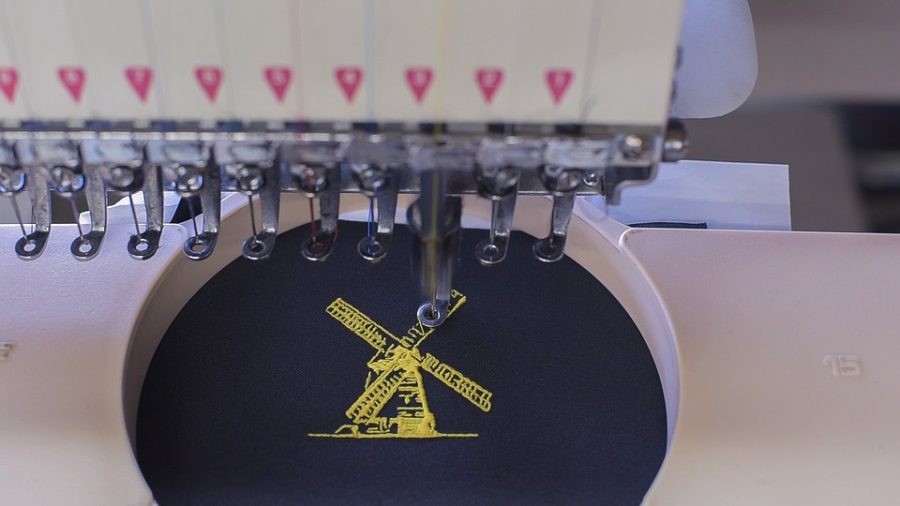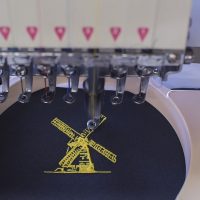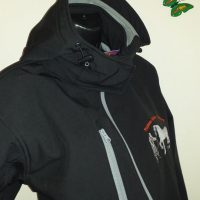Embroidery vs Printing – Which should I choose?
Usually, there are two main options when it comes to personalising fabrics with your own design. Embroidery, or printing, but which should you go for?
There are numerous reasons why you might want to customise clothing or textiles. You might be a business investing in branded workwear for your staff, a hotel or spa wanting to add a logo to your bathrobes or towels, alternatively, you might want your sports team to bear your club’s crest with pride. For these and myriad other reasons, getting a plain garment customised makes it your own.
Embroidery is more durable
When your printed or embroidered shirt is first delivered, both will look fabulous, however, with wear and tear, time and a few washes, the custom printing may well be starting to fade, crack or peel. An embroidered design though, should last the life of the garment and continue to look good well beyond what you’d get from a printed design.
If your design is for a one off event, then perhaps the cheaper option, which would normally be printing, is the one you’d probably go for, but in all other cases, especially for staff uniforms, embroidery is far more durable and therefore the better option.
Designs Need to Be Converted For Embroidery
While we have a section of pre-programmed fonts, patterns and motifs on file to choose from, if you want your design or logo embroidering, the design will have to converted from an image file to an embroidery design (digitised). This is a skilled job, using specialist software, a task which we outsource and charge at cost, but once this has been done, it can be used forever.
Printing a design however, needs little to no conversion and a suitable image file can be printed directly onto a garment or transfer. Depending on the print method used, results look good and for good quality processes can last for quite a while.
Embroidery vs Printing – Not all fabrics are suitable
Printed designs tend to work best of smoother fabrics, with print quality deteriorating on fabrics with courser surfaces. Embroidery however, works well with a variety of materials. A standard polo shirt may well be too loosely woven for printing to look its best, but embroidery is far more forgiving. Neither embroidery nor printing will work well with chunky woollen knits though!
Embroidery vs Printing – Which is cheaper?
Price is quite often a factor and while some types of printing may well be cheaper than embroidery, it’s not by much. Quantity is often a factor though.
The type of printing used can dictate the price of the job as well s the quality. Direct to Garment Printing (DTG) or transfer printing of one sort or another can be done fairly cheaply even in small quantities. Silk Screen Printing is generally the best of all the methods of printing designs, however to do it properly needs specialist equipment a fair amount of space and quite a lot of setting up (there’ll almost certainly be a set up fee), for this reason, it’s only really cost effective for large production runs.
Embroidery in reality is often somewhere in the middle. It might cost a little more than the cheaper types of printing, but if quality is a factor, it’s far more cost effective than screen printing, especially for smaller orders.
For both embroidery or printing, it has to be said that much of the cost of a job is taken up by the purchase of the garment itself. Cheap, poor quality t-shirts won’t work so well with embroidery, but they can usually be printed on, so if a one off ‘disposable’ t-shirt is what you’re after, printing may be the way to go.
If you’re investing in custom clothing, we’d always recommend going for the best fabrics you can. They last longer and they take embroidery better. We’re able to source garments and textiles from a range of manufacturers at a range of prices, so we’re confident we can arrange for what you need at a price you can afford.
Which finish looks better?
It’s a little subjective, but naturally, we think embroidery looks far nicer in most circumstances. For custom workwear especially, having embroidered uniforms adds an extra element of class and makes your brand stand out when worn by your customer facing staff.
Because of the stitching process, embroidery sits slightly proud of the surface it’s applied to and as such has a textured 3D effect. Additionally, the coating on each individual thread catches the light adding an extra dimension to the design. When converting designs for embroidery, skilled digitisers often make use of the texture and direction of stitches to add extra nuance to the pattern.
With printing and depending on the process used, finer detail is sometimes possible with printed designs and when new the finish can look every bit as good as embroidery, however, the design will always be strictly two dimensional.
Embroidery vs Printing – Any Questions?
While we hope we’ve covered everything, if you have any other queries about embroidery vs printing, or any other embroidery related questions for that matter, please don’t hesitate to contact us, we’d be delighted to hear from you.








Comments are closed.